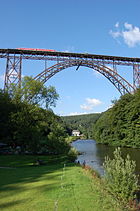Wupper
| Wupper | |
|---|---|
 Wupper | |
| Location | |
| Country | Germany |
| State | North Rhine-Westphalia |
| Physical characteristics | |
| Source | |
| • location | Sauerland |
| • elevation | 441 m (1,447 ft) |
| Mouth | |
• location | Rhine |
• coordinates | 51°02′43″N6°56′27″E/ 51.04528°N 6.94083°E |
| Length | 115.8 km (72.0 mi)[1] |
| Basin size | 813 km2(314 sq mi)[1] |
| Discharge | |
| • average | 17 m3/s (600 cu ft/s)[2] |
| Basin features | |
| Progression | Rhine→North Sea |
| Tributaries | |
| • left | Dhünn |
TheWupperis a righttributaryof theRhinein the state ofNorth Rhine-Westphalia,Germany.Rising nearMarienheidein westernSauerlandit runs through the mountainous region of theBergisches Landin Berg County and enters the Rhine atLeverkusen,south ofDüsseldorf.Its upper course is called the Wipper. Both names are related to "weave", and refer to the twisting course.[3]

On its course of about 116 kilometers (72 mi), the Wupper passes through the city ofWuppertalwhere thesuspension railwayruns for 10 kilometers (6.2 mi) above the river.
It is crossed by the highestrailwaybridge in Germany near Müngsten, betweenRemscheidandSolingen.A few kilometers further down,Burg Castleis located on a hill overlooking the river.
Hydropower
[edit]From the 15th century, the Wupper and its numerous streams gave birth to hundreds of workshops, mills and factories on their banks. Originally water was used for dying,bleachingand washing canvas and cloth,[4]later it was used to power machines or transport waste.
The Wupper thus facilitated the early industrial expansion ofWuppertal(German for "Wupper Valley" ) during the 18th, 19th, and early 20th centuries. The Wupper Valley was one of world's first industrialized regions and empoweredinter aliatheRuhrgebietas a coal-mining region.

Tributaries
[edit]The following rivers are tributaries to the river Wupper (from source to mouth):[1]
- Left:Gaulbach,Brunsbach,Pixwaager Bach,Dörpe,Wilhelmstaler Bach,Hardtbach, Lohbach, Nöllenberger Bach, Stoffelsberger Bach, Hofsiefen,Hengstener Bach,Steinhauser Bach, Lohmühlenbach,Herbringhauser Bach,Marscheider Bach,Eschensiepen,Blombach,Norrenberger Bach,Murmelbach,Fischertaler Bach, Springer Bach, Kothener Bach,Auer Bach,Bendahler Bach,Klusensprung, Holzer Bach,Hatzenbeck,Ossenbeck,Rutenbeck,Glasbach,Burgholzbach,Weilandsiepen,Kaltenbach,Morsbach,Eschbach,Sengbach,Weltersbach,Murbach,Wiembach,Dhünn.
- Right:Kerspe,Hönnige,Neye,Bever,Frohnhauser Bach,Wiebach,Kretzer Bach,Uelfe,Remlingrader Bach,Spreeler Bach,Steinhauserbergbach, Nebenkämper Siefen, Ehrenberger Bach, Steinbruch Siefen, Schmitteborner Bach, Hebbecke,Schwelme,Schwarzbach,Leimbach,Schönebeck,Mirker Bach,Briller Bach,Varresbeck,Lüntenbeck,Rottscheider Bach,Buchenhofener Siepen.
Other
[edit]- On July 21, 1950, a young elephant named Tuffi, made to ride on the train by her handler as an advertising stunt, decided she did not like the ride, panicked (and panicked the other, human, passengers), burst out of the car she was riding in, and jumped or fell into the Wupper, only slightly injuring herself. In 1970 Marguerita Eckel and Ernst-Andreas Ziegler published a children's picture book about the incident,Tuffi und die Schwebebahn.
- The Wupper is cited in the German sayings: "Über die Wupper gehen", literally "To go over the Wupper", metaphorically meaning "going bankrupt", "going into jail" or "going to die".[5]
- Else Lasker-Schülerwrote a drama entitledDie Wupper.
See also
[edit]References
[edit]- ^abcHydrographic Directory of the NRW State Office for Nature, the Environment and Consumer Protection (Gewässerverzeichnis des Landesamtes für Natur, Umwelt und Verbraucherschutz NRW 2010)(xls; 4.67 MB)
- ^Die Wupper// Wupperverband(in German)
- ^"Wippen".April 7, 2022.
- ^"Cloth Bleaching alongside Wupper River".Municipality of Wuppertal.RetrievedJanuary 12,2011.
- ^Rolf-Bernhard Essig."Woher kommt" Über die Wupper gehen "?"(in German).SWR.RetrievedSeptember 2,2014.

